Small Evergreen Shrubs (With Pictures) – Identification Guide
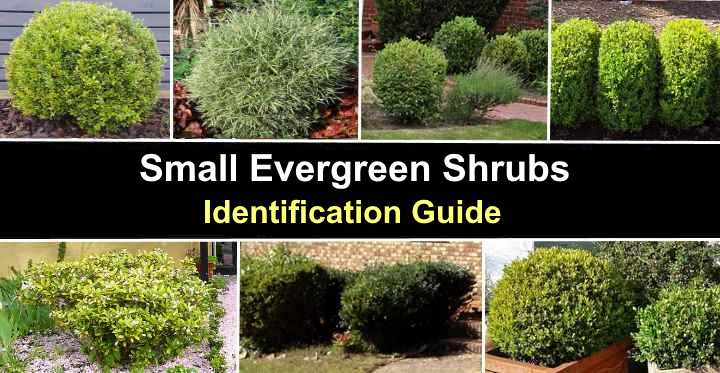
Small evergreen shrubs are a popular choice for garden landscapes across the country. Whether you want to add greenery to your front yard or create a cozy backyard retreat, evergreen bushy plants are ideal solutions. These low-growing shrubs are known for their robustness, year-round foliage, and low maintenance needs. These growth features make them the perfect choice for busy homeowners who want to enjoy a beautiful garden without spending too much time in the yard.
With a wide range of sizes, colors, and textures, there’s sure to be a small evergreen shrub perfect for your garden. Whether you want a hardy conifer shrub or a flowering evergreen bush, you can enhance your garden’s aesthetics with various shrubs that keep their foliage throughout the year.
This article is an identification guide to small evergreen shrubs. Descriptions of their identifying features and pictures of the best compact evergreen shrubs will help you choose the best plants for your garden landscape.
What Are Small Evergreen Shrubs?
Small evergreen shrubs are bushy plants that maintain their green foliage throughout the year, regardless of the season. The shrubs are typically low-growing, drought-tolerant, and compact, not reaching over 5 ft. (1.5 m) in height. Their compact growth habit makes them ideal for gardens and landscaping.
Small bushes for landscaping range from a few inches tall to five feet (1.5 m) in height. The shrubs come in various shapes, colors, and textures—some have coniferous feathery foliage, whereas others are broadleaf bushes. Common types of small evergreen shrubs include boxwood, wintercreeper, juniper, and dwarf conifers.
Advantages of Small Bushes For Landscaping
Low-growing evergreen shrubs are excellent landscaping choices for tight corners, compact gardens, or limited space. You can plant the shrubs to create a natural border or boundary, plant along a foundation line, or create a layered effect in your front-of-house landscaping design. Additionally, they provide a natural habitat for plenty of wildlife.
Small shrubs under 5 feet tall are ideal as borders, evergreen hedges, or specimen plants. Also, low-growing shrubs under two feet tall can be ground cover in sun or shade. Small evergreen shrubs add year-round interest and structure to your outdoor space regardless of how you use them.
Small Evergreen Shrubs (With Pictures and Names)
Let’s look in more detail at some of the best small evergreen shrubs for landscaping a front or back yard.
Small Wintercreeper Shrubs (Euonymus fortunei)
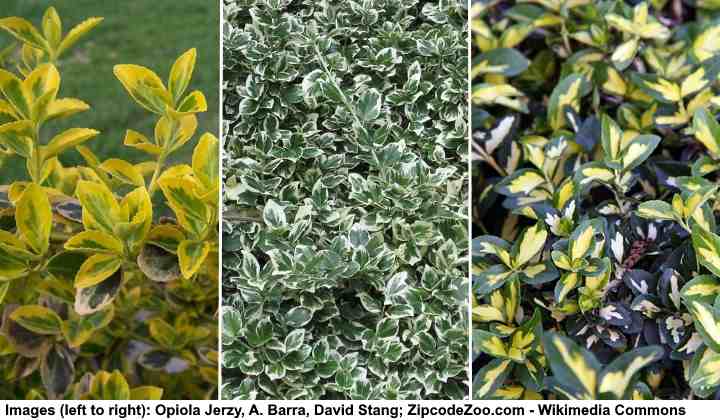
The colorful foliage of small evergreen wintercreeper shrubs add an ornamental element to any garden. This picture shows the compact cultivars: ‘Emerald ‘n’ Gold’, ‘Emerald Gaiety’ and ‘Moonshadow’
Small wintercreeper shrubs are versatile plants that never lose their leaves. Many species of these low-growing landscaping bushes grow 1 to 5 ft. (0.3 – 1.5 m) tall. The small evergreen wintercreeper shrubs are known for their small, pointed, variegated leaves, spreading habit, and greenish flowers. Landscape uses include ground cover, foundation planting, low hedges, and edging plants.
Here are some examples of wintercreeper shrubs under five feet tall:
Wintercreeper ‘Emerald ‘n’ Gold’—A low-growing evergreen landscaping bush under two feet. (0.6 m) tall. The identifying features of the compact shrub are greenish-yellow leaves with a yellow margin.
Wintercreeper ‘Harlequin’—A small evergreen shrub 1.5 ft. (0.45 m) tall with a bushy growth habit and variegated foliage in shades of green, cream, and pink in fall and winter.
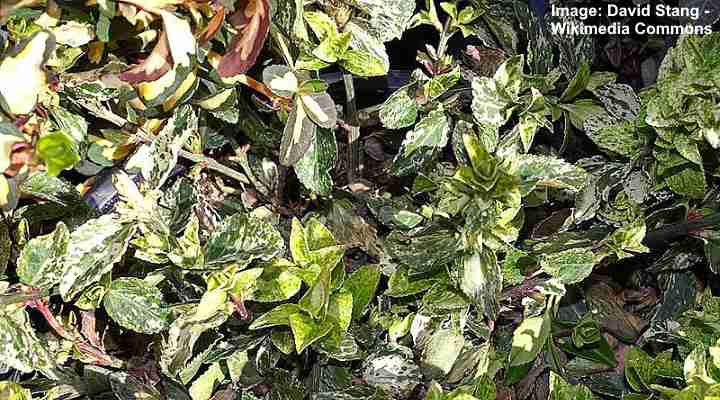
Wintercreeper ‘Harlequin’ (Euonymus fortunei ‘Harlequin’)
Wintercreeper’ Emerald Gaiety’—This evergreen shrub grows 4 to 5 ft. (1.2 – 1.5 m) tall and is characterized by its emerald green leaves with broad creamy-white margins.
Wintercreeper’ Gold Splash’—The brightly-colored yellow and green low-growing shrub grows less than two feet (0.6 m) tall. Its creeping growth habit makes it ideal for ground cover in the shade.
Wintercreeper ‘Moonshadow’—This small shrub reaches 3 ft. tall (0.9 m) and has brightly colored yellow and green foliage. Grow as a small border shrub wherever you need bold colors in your front or back garden.
Evergreen wintercreeper shrubs are suitable for USDA zones 5 to 9 and thrive in full sun or partial shade.
Small Boxwood Shrubs (Buxus)

Place small evergreen boxwood shrubs in the front of house to increase the curb appeal or as a decorative element in your backyard
Small boxwood shrubs are versatile evergreen bushy plants, ideal as borders, low-growing hedges, or accent plants. Boxwood shrubs for landscaping have a rounded, pyramidal, or irregular growth. They are identified by their small, glossy, compact shape and low maintenance requirements. The small shrubs thrive in USDA zones 5 to 9.
Dwarf and compact boxwoods that grow only a few feet tall are perfect for creating hedges, topiaries, and other formal garden features.
Here are a few varieties of evergreen boxwood shrubs suitable for a front or backyard:
Boxwood’ Green Velvet’—This compact evergreen shrub has a broadly mounded round shape with glossy, dark green leaves. Thriving in partial shade, the shrub grows 3 to 4 ft. (1 – 1.2 m) tall and wide.
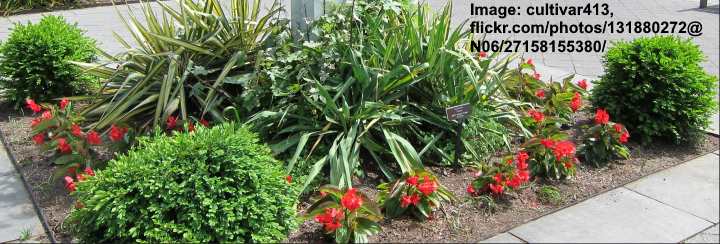
‘Green Velvet’ boxwood (left, bottom and right)
Japanese boxwood ‘Green Beauty’—Reaching up to 5 ft. (1.5 m) tall, Buxus microphylla var. japonica produces tiny, lanceolate, glossy green leaves throughout the year. Like all boxwood varieties, it is tolerant of drought.
Small-leaved boxwood ‘Faulkner’—Ideal for a shade garden, this compact, evergreen, low-growing shrub has lush foliage consisting of oval bluish-green leaves. The Buxus microphylla shrub variety grows 3 to 4 ft. (1 – 1.2 m) tall.
Korean boxwood ‘Nana’—This slow-growing evergreen shrub grows up to 2 ft. (0.6 m) tall and 3 ft. (1 m) wide. New leaves emerge lime green before turning dark green in summer.
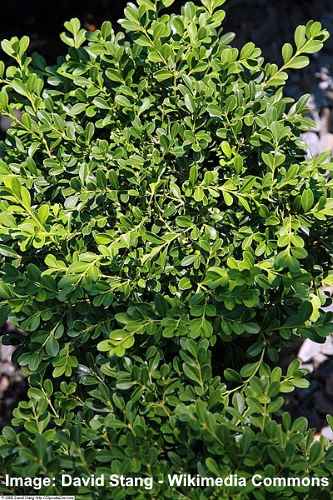
Korean Boxwood ‘Nana’ (Buxus sinica var. insularis ‘Nana’)
Small evergreen boxwood shrubs are suitable for growing in full sun to complete shade.
Winter Heath (Erica carnea)
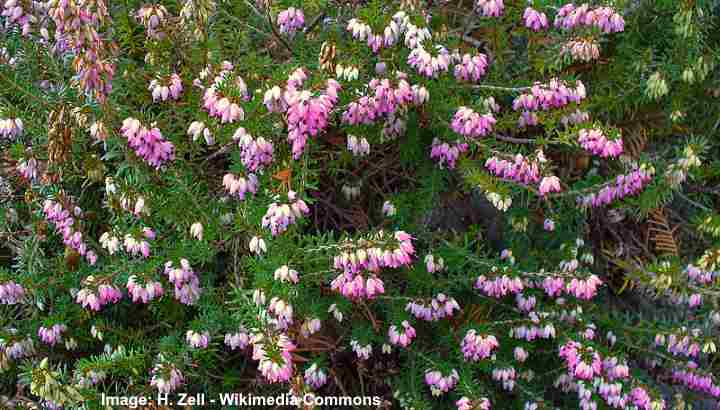
The ornamental small winter heath shrub is grown for its evergreen foliage and purple flowers and is suitable for full sun
Winter heath is a group of low-growing shade tolerant evergreen shrubs under two feet tall. The shrubby plants are characterized by their clusters of bell-shaped flowers blooming in pink, purple, and white shades. The shrub’s needle-like dark green foliage provides year-round interest in sunny garden landscapes.
Winter heath shrubs are low-maintenance and are ideal for planting in full sun, growing 0.5 to 2 ft. (0.15 – 0.6 m) tall. They bloom in late winter and early spring, adding a splash of color to bare landscapes. The shrubs perform best in well-drained soil and are perfect for rock gardens, coastal regions, borders, and containers.
Winter heath is suitable for growing in USDA zones 5 to 7.
Small Holly Shrubs (Ilex)
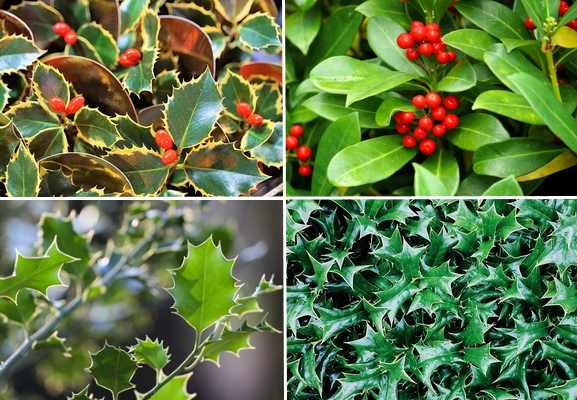
Holly shrub leaves can be spiked or smooth, green or variegated
Small holly shrubs are known for their evergreen leaves and bright red winter berries. The smallest varieties of evergreen shrubs in the genus Ilex grow 1 to 5 ft. (0.3 – 1.5 m) tall and 4 ft. (1.2 m) wide. Small holly shrubs typically have dense foliage and a rounded growth habit.
Here are a few examples of small holly shrubs for your garden landscape:
Ilex vomitoria ‘Nana’—The small evergreen has a dense, rounded growth habit with small, dark green leaves. It grows 3 to 5 ft. (1 – 1.5 m) tall.
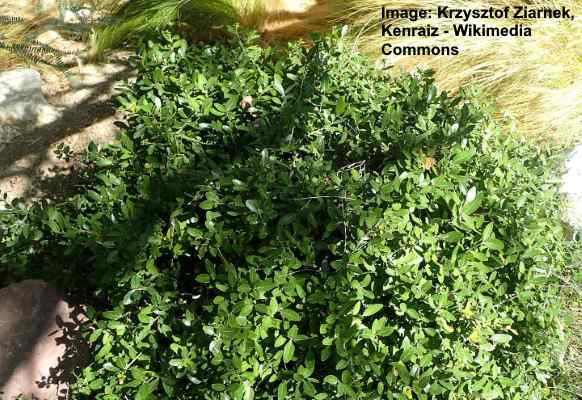
Ilex vomitoria ‘Nana’
Ilex crenata’ Sky Pointer’—Ideal for adding vertical accent in a compact landscape, this slender, pencil-like shrub grows 4 to 5 ft. (1.2 – 1.5 m) tall and up to 4 ft. (1.2 m) wide. It looks attractive growing at the corner of a house or in containers beside an entranceway.
Ilex glabra ‘Compacta’—This compact evergreen holly shrub grows 3 to 4 ft. (1 – 1.2 m) tall and up to 6 ft. (1.8 m) wide. Ideal for full sun or part shade in USDA zones 4 to 9, its evergreen foliage makes it ideal for foundation planting, a low hedge, or a shrub border.
Compact Oregon Grape (Mahonia aquifolium ‘Compacta’)
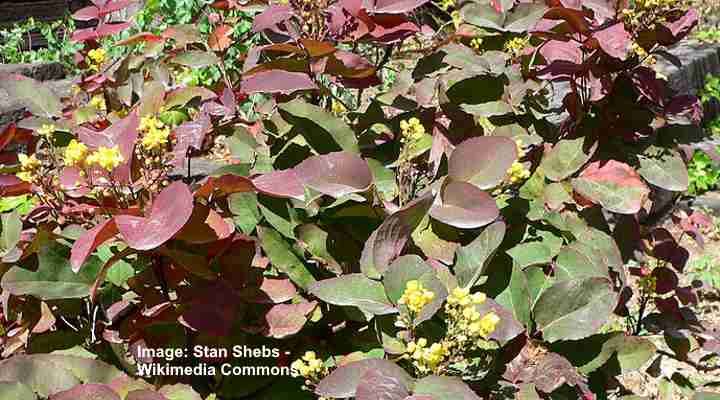
The leaves of the compact Oregon holly grape are evergreen, but they change colors throughout the year
Oregon holly grape is a compact evergreen shrub for shade gardens. The hardy shrub is characterized by its glossy green leaves with spiny edges and clusters of fragrant, yellow cup-shaped flowers. The eye-catching leaves turn purple-red in winter, and the yellow flowers emerge in late winter or early spring, followed by blue-black berries in summer.
Because its foliage is like holly leaves, the shrub is also called the Oregon holly grape. It’s a slow-growing shrub that reaches 2 to 3 ft. (0.6 – 1 m) tall and 5 ft. (1.5 m) wide. The compact shrub is ideal for growing as a small flowering hedge, border plant, or front-of-the-house planting.
Oregon holly grape is suitable for growing in USDA zones 5 through 9.
Small Pine Shrubs (Pinus)
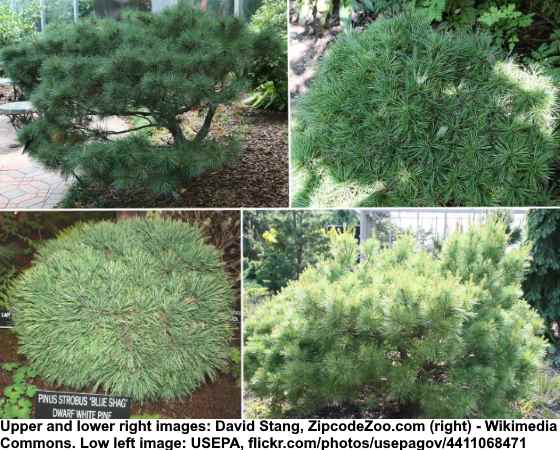
Dwarf evergreen pine shrub cultivars include (clockwise from top left): ‘ Nana’, ‘Horsford’, ‘Green Globe’ and ‘Blue Shag’
Many varieties of low-growing pine shrubs are ideal for ornamental evergreen landscaping. The shrubby coniferous plants add texture to gardens throughout the year with their spiky needle-like leaves, mounding growth, and cold-hardiness. Depending on the pine variety, the small conifer shrubs grow 1 to 6 ft. (0.3 – 1.8 m) tall and up to 10 ft. (3 m) wide.
Here are some popular small pine shrubs to consider for foundation planting, evergreen borders, or coastal gardens:
Pinus strobus ‘Nana’—The dwarf variety of the Eastern White pine has a dome shape, silvery-blue needles, and dense, compact growth.
Pinus sylvestris ‘Pumila’–The dwarf Scotch pine has bluish-green needle leaves growing on upward-pointing stems and a globe-shaped form.
Pinus strobus ‘Horsford’—Another stunning dwarf evergreen pine shrub with needle foliage and an oval growth habit. The stumpy shrub won’t grow over 1 ft. (30 cm) tall.
Pinus mungo ‘Mops’—Commonly called dwarf mountain pine, this coniferous bushy plant has a rounded growth of soft silvery-blue needles. The slow-growing shrub grows 3 to 4 ft. (1 – 1.2 m) tall.
Pinus pumila ‘Glauca’—Hardy to USDA Zone 3, the dwarf Siberian pine has distinctive gray-blue needle leaves, small erect pine cones, and upswept branches. The attractive ornamental conifer shrub grows 3 to 4 ft. (1 – 1.2 m) tall.
Pinus strobus Vanderwolf’s Green Globe —As with many dwarf pine shrubs, this evergreen is a rounded bushy conifer with green needles. This miniature Eastern White pine variety thrives in full sun.
Pinus strobus ‘Blue Shag’—This dwarf Eastern white pine is an evergreen coniferous shrub ideal for growing in containers. It has a globe shape with soft, bluish-green needles. Although it grows to 6 ft. (1.8 m), it takes many years to reach that height.
Gold Mop Cypress (Chamaecyparis pisifera ‘Golden Mop’)
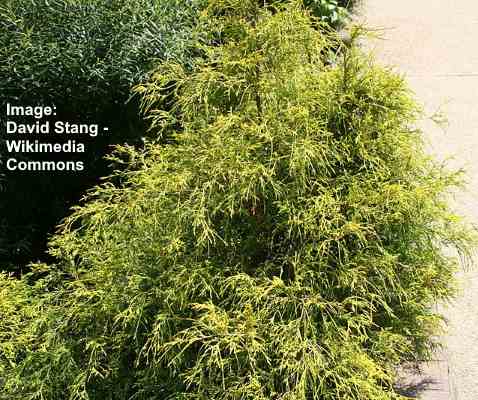
Gold Mop cypress is a small evergreen easy care shrub with ornamental yellow green foliage
Gold mop cypress is a stunning evergreen shrub with a conical form and long, drooping yellowish-green leaves. The stunning feature of this cypress cultivar is its dangling cord-like foliage in bright yellowish-green colors. This coniferous shrub also has a dense, rounded form.
It’s a slow-growing shrub and reaches 1 to 5 ft. (0.3 – 1.5 m) tall and wide.
Gold mop cypress thrives in full sun or partial shade in USDA zones 4 to 8. You can grow the hardy evergreen in foundation plantings, an evergreen hedgerow, or as a specimen plant.
David Viburnum (Viburnum davidii)

The ornamental small David viburnum shrub has creamy pink flowers and dark foliage
David viburnum is a slow-growing, evergreen landscaping shrub under five feet tall. Characteristics of the attractive bushy plant are its dark green, lanceolate leaves, flat-topped clusters of star-shaped flowers, and metallic blue berries. It’s good to note that the shrub’s foliage in USDA zones 6 and below is deciduous, not evergreen.
David viburnum grows 3 to 5 ft. (1 – 1.5 m) tall and wide, perfect for compact sunny landscapes in mild winter regions. The compact, white-flowering shrub is an excellent choice for foundation plantings, mixed borders, and low hedges.
It’s also drought-tolerant and easy to maintain, making it a popular choice for gardeners in southern states.
Glossy Abelia (Abelia grandiflora)
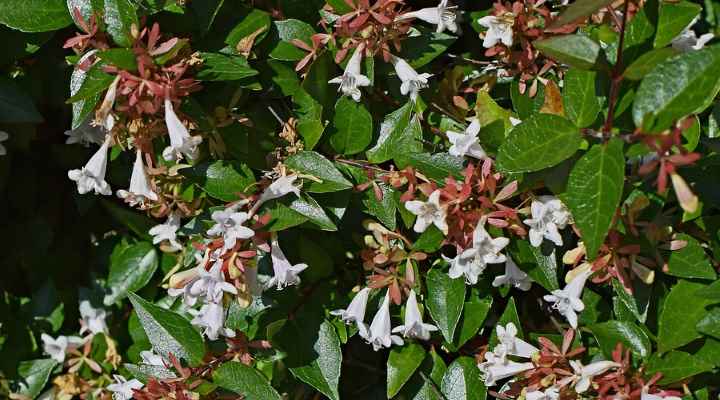
Glossy abelia is an evergreen shrub in warmer climates with white-pink flowers that is shade-tolerant
Glossy abelia is a semi-evergreen ornamental shrub with clusters of whitish-pink flowers that bloom from late spring through fall. The small, pink or white trumpet-shaped tubular flowers measure 0.5” long and grow in small clusters. The shrub’s blossoms contrast with the glossy, dark green leaves.
The compact glossy abelia shrub grows 3 to 6 ft. (0.9 – 1.8 m) tall and wide. Being semi-evergreen, it loses its leaves in winter in zones 6 and 7. However, the shrub’s foliage stays green throughout the year in southern states like Florida or Texas.
This drought-tolerant plant is an excellent choice for a low-growing informal hedge, foundation planting, specimen plant, or mixed border. The fragrant flowers attract pollinators to the garden, and the colorful foliage adds visual interest to garden landscapes.
Small Evergreen Doghobble Shrub (Leucothoe fontanesiana)
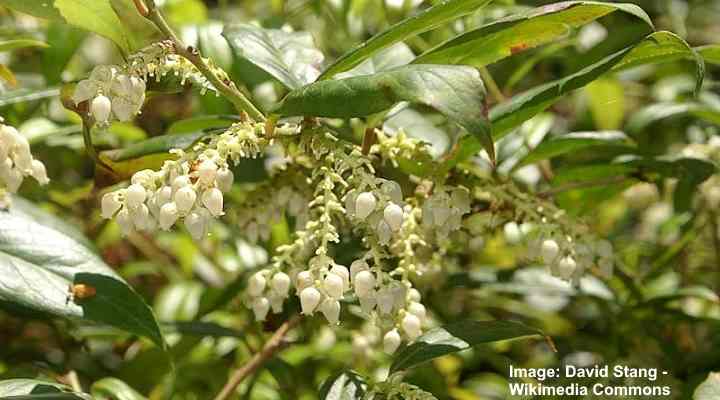
The shade tolerant dog hobble evergreen shrub has delicate white flower clusters and is quite small
Also known as drooping laurel, doghobble is a small shade-loving evergreen shrub with grape-like clusters of creamy-white bell-shaped flowers. The ornamental features of the shrub are its leathery green lance-shaped leaves, white flowers, and gracefully arching reddish branches. Doghobble shrubs grow 3 to 6 ft. (0.9 – 1.8 m) tall and wide.
Doghobble is an excellent gardening solution for shade gardens. The drooping clusters of flowers bloom in spring and summer, attracting butterflies to shaded areas of your landscape. You can plant the shrub as an understory plant, shrub border or let it grow as white-flowering ground cover.
Small evergreen doghobble shrubs grow best in USDA zones 5 through 8.
Small Evergreen Arborvitae (Thuja) Shrubs
Arborvitae conifers belong to the cypress family Cupressaceae. Small arborvitae shrubs are evergreen conifers that are popular landscaping plants for low hedges, specimen shrubs, or foundation plantings. Dwarf varieties of arborvitae shrubs usually grow up to 4 feet (1.2 m) tall.
Here are some examples of decorative dwarf arborvitae shrubs to plant in your garden:
Little Giant Dwarf Arborvitae (Thuja occidentalis ‘Little Giant’)—The ‘Little Giant’ arborvitae is a globose shrub that stays green throughout the year. The round shape of this dwarf conifer makes it suitable as an accent plant, foundation plant, or in containers at an entranceway. Grows 4 ft. (1.2 m”) tall and wide.
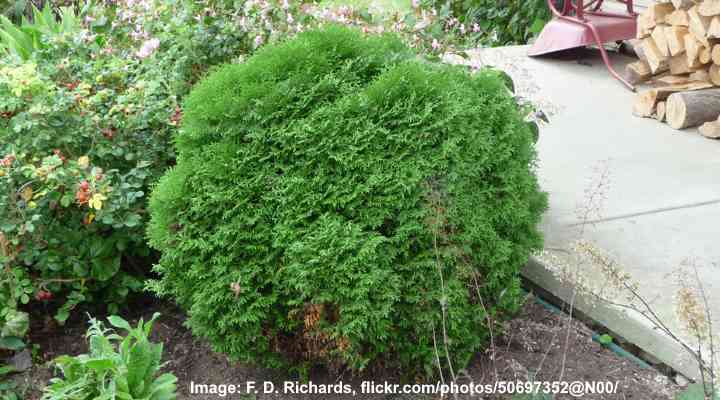
Thuja occidentalis ‘Little Giant’
Thuja orientalis ‘Aurea Nana’—The dwarf arborvitae ‘Aurea Nana’ is a cone-shaped conifer with a slightly rounded form. The decorative evergreen shrub has yellowish-green foliage that turns bronze in winter. The miniature shrub thrives in zones 6 to 9 and grows 2 to 5 ft. (0.6 – 1.5 m) high and up to 4 ft. (1.2 m) wide.

Thuja orientalis ‘Aurea Nana’
Thuja occidentalis ‘Fire Chief’—The Thuja cultivar ‘Fire Chief’ is a miniature landscaping shrub with a rounded, ball-like shape. The attractive feature of this ‘Fire Chief’ is its golden spring foliage that turns green and then develops fiery red tips in the fall. Grows 3 to 4 ft. (1 – 1.2 m) tall and wide.

Thuja occidentalis ‘Fire Chief’
Dwarf ‘Hetz Midget’ arborvitae (Thuja occidentalis ‘Hetz Midget’) – This is a round dwarf arborvitae with attractive dark green foliage that turns into hues of bronze in the winter. Being one of the shortest arborvitae shrubs, the ‘Hetz Midget’ is best for foundation plantings, mixed borders, miniature hedges, or rock gardens. This dwarf Thuja is also perfect as a container plant on terraces, patios, or porches. Height: 3 or 4 ft. (1 – 1.2 m).
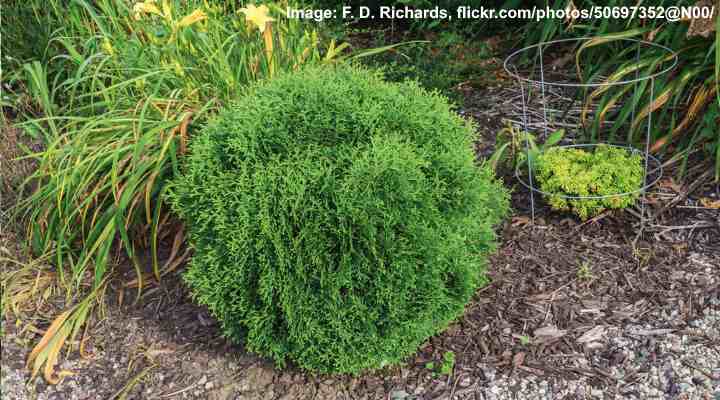
Thuja occidentalis ‘Hetz Midget’
Dwarf Western Red Cedar (Thuja plicata ‘Pygmaea’)—The dwarf coniferous shrub has attractive green foliage that turns bronze in the winter. The densely packed evergreen scale-like leaves make this beautiful shrub an ideal hedge, shrub border, or potted tree. The pygmy conifer grows 2 to 3 ft. (0.6 – 1 m) tall and wide and suitable for zone 5 to 8.
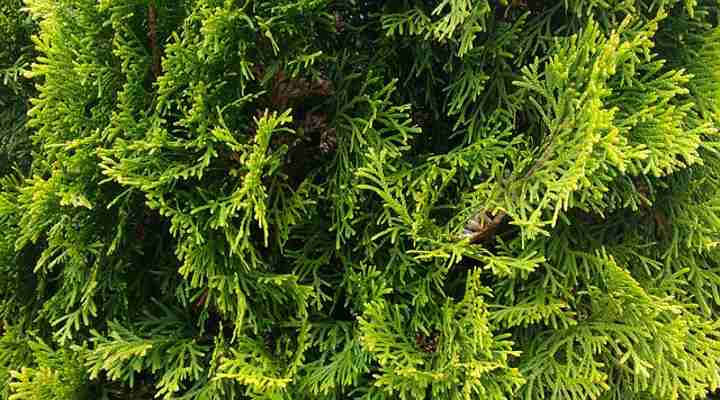
Thuja plicata ‘Pygmaea’
Garland Flower (Daphne cneorum)
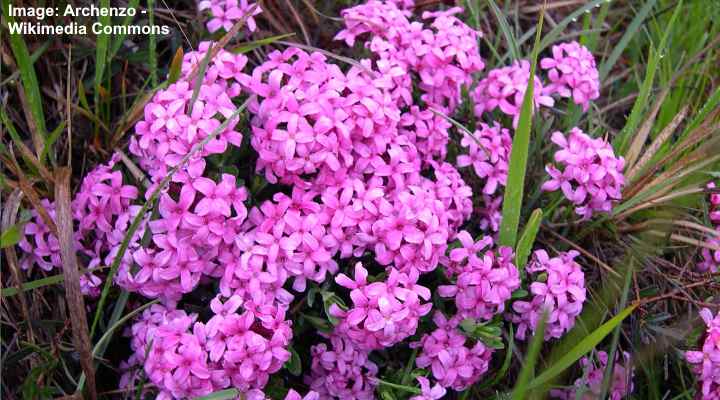
Garland flower is a trailing low growing evergreen shrub for partial shade with attractive pink flowers
The garland flower, also known as rose daphne, is a trailing, small evergreen shrub adorned with masses of fragrant, bright pink flowers. These four-petaled, star-shaped flowers bloom intermittently from spring through summer. Its sprawling, prostrate branches are covered with small, narrow, shiny green leaves. This compact shrub typically reaches a height of 0.5 to 1 foot (0.15 – 0.3 m) and spreads to 3 ft. (1 m) in width.
Garland flower is ideal for planting in rock gardens, front of border, foundation planting, and pink-flowering ground cover. The low-maintenance shrub prefers well-draining soil and full sun to partial shade.
Garland flower is suitable for growing in USDA zones 5 to 8.
Minuet Mountain Laurel (Kalmia latifolia ‘Minuet’)
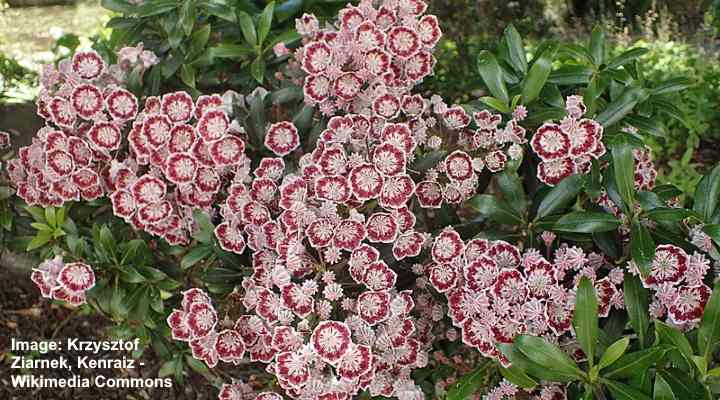
The beautiful mountain laurel ‘Minuet’ is a versatile small flowering shrub that is adaptable to many conditions
Minuet mountain laurel is a beautiful small evergreen shrub with clusters of light pink flowers, gnarled branches, and glossy, leathery evergreen leaves. This low-growing shrub for landscaping has showy clusters of small, cup-shaped flowers that emit a sweet fragrance.
This ornamental shrub grows 2 to 3 ft. (0.6 – 0.9 m) tall and wide and prefers partial to full shade.
The minuet mountain laurel is ideal for mass plantings, creating shrub borders, pink-flowering hedges, or growing along a foundation line. It’s also a low-maintenance shrub that is deer-resistant and attracts hummingbirds and butterflies.
Minuet mountain laurel is suitable for growing in USDA zones 4 to 9.
Small Japanese Spindle Shrubs (Euonymus japonicus)
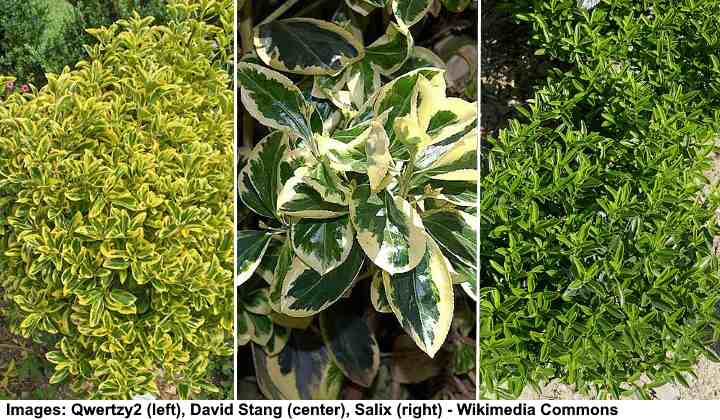
The colorful foliage of small evergreen Japanese spindle shrubs add an ornamental element to any garden. This picture shows the cultivars: Aureo-Marginatus, Silver King and Microphyllus
Small Japanese spindle shrubs are eye-catching bushy plants with year-long foliage, perfect for planting in small sunny gardens. The highlight of Japanese spindle shrubs is the small, linear glossy green and yellow leaves growing on upright stems. Low-growing Japanese spindle shrubs don’t grow taller than 3 ft. (1 m) tall.
Japanese spindle shrubs are ideal for landscaping along a foundation line or as full sun ground cover. They are also suitable for growing in containers to brighten a sunny patio, deck, or balcony.
Small Japanese spindle shrubs thrive in USDA zones 6 to 9 in well-drained soil.
Small Evergreen Chinese Fringe Flower Shrub (Loropetalum chinense ‘Emerald Snow’)
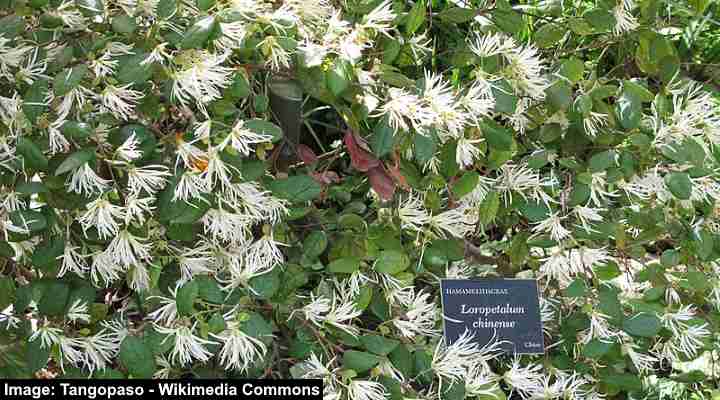
The small evergreen Chinese fringe flower ‘Emerald Snow’ is a compact shrub with white wispy flowers
The ornamental features of the Chinese fringe flower shrub are its pure white flowers with spindly, twisted petals. This low-maintenance mounding small evergreen shrub also has oval emerald leaves creating dense foliage. Chinese fringe flower grows 2 to 3 ft. (0.6 – 1 m) tall and up to 4 ft. (1.2 m) wide.
Landscaping uses for Chinese fringe flower shrubs include informal hedgerows, foundation plantings, or containers in sunny patios. Other varieties of Chinese fringe flower shrubs have hot pink, spidery flowers, and blue-green leaves.
Small evergreen Chinese fringe flower is suitable for growing in USDA zones 7 to 10.
Japanese Skimmia (Skimmia Japonica)
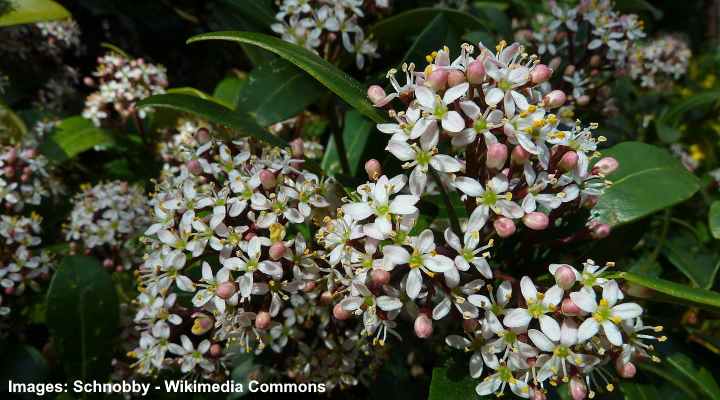
Japanese skimmia is a small flowering evergreen shrub that is easy to care for and loves shade
Ideal for shade gardens, Japanese skimmia is a small evergreen shrub prized for its fragrant, creamy-white star-shaped flowers and clusters of bright red berries. The large flower clusters are conical-shaped and stand upright on the bushy shrub. Japanese skimmia grows 3 to 4 ft. (1 – 1.2 m) tall and wide.
Slow-growing Japanese skimmia thrives in full shade and is ideal for growing on the north-facing side of a house or fence line. The evergreen shrub also grows as an attractive hedge, specimen, or container plant.
Japanese Skimmia is suitable for planting in USDA zones 6 to 8.
Bird’s Nest Spruce (Picea abies ‘Nidiformis’)
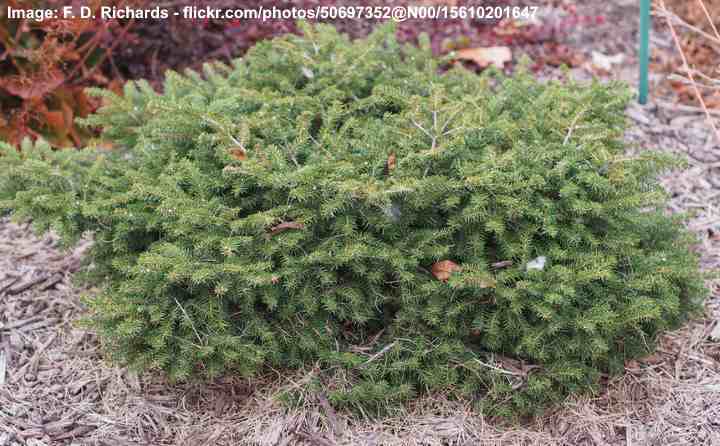
The birds nest spruce is a slow grower small evergreen shrub with round shape and flat top
Bird’s nest spruce is a low-growing, spreading evergreen shrub growing in a broadly rounded, symmetrical shape. This ornamental coniferous shrub is easy to identify due to its unique shape—a dense, rounded form with a depression in the middle resembling a bird’s nest. The dark green foliage is needle-like and grows in a spiral pattern around the stem.
Bird’s Nest Spruce grows 3 to 4 ft. (1 – 1.2 m) tall and up to 8 ft. wide. Ideal for USDA growing zones 3 to 8, it works well in landscapes as a foundation planting, border front, or accent in sunny garden landscapes.
Related articles:
- Small Flowering Shrubs
- The Best Foundation Plants for Your Front Yard
- Landscaping Shrubs with Yellow Leaves or Flowers
